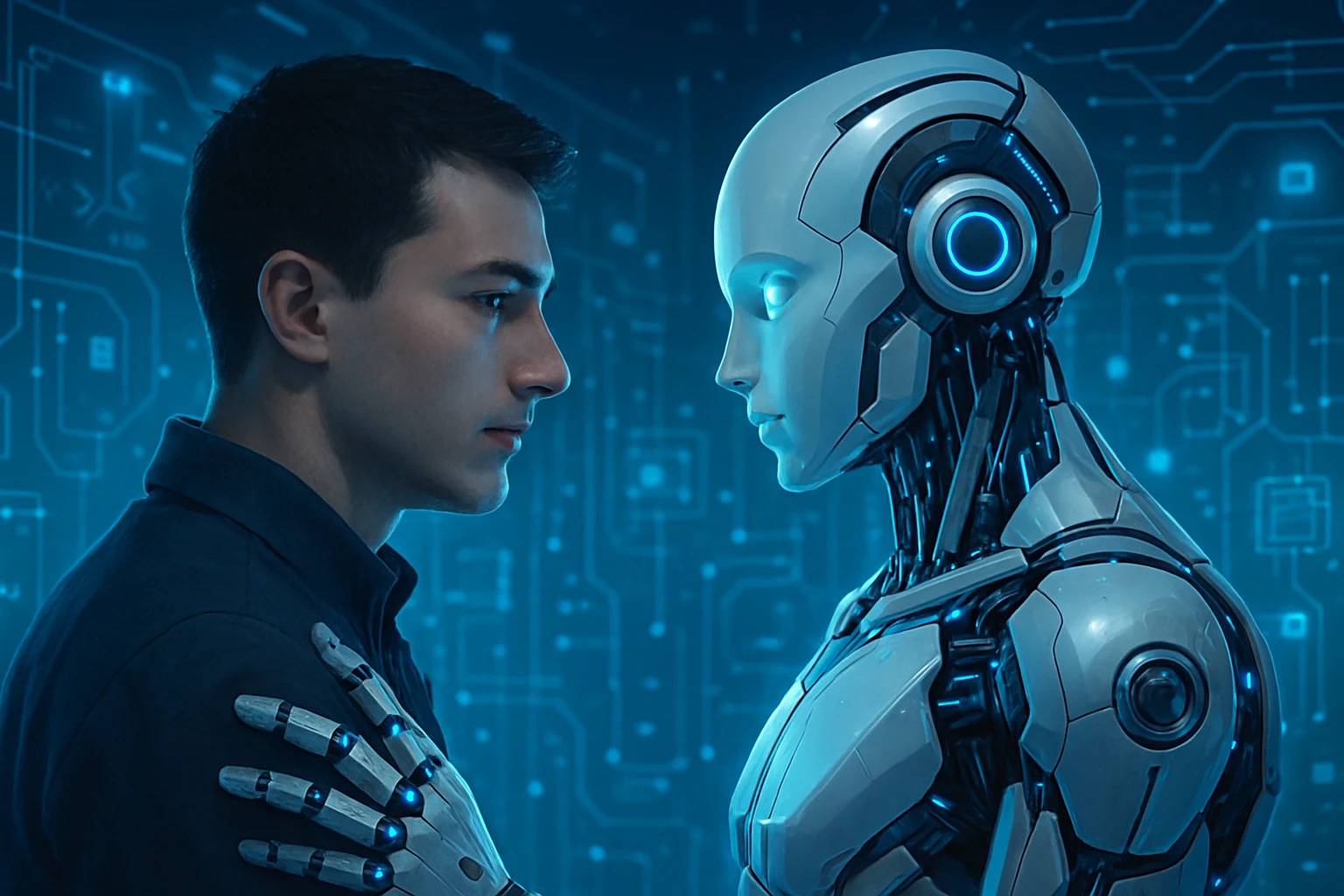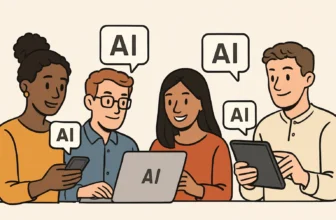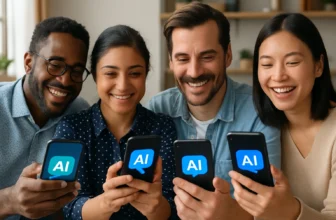
The AI Assistant Evolution: A Sneak Peek
What if your AI assistant knew you so well, it could book your weekend getaway before you even realized you needed a break? Sounds a bit creepy—or kind of amazing? Either way, that scenario is a lot closer than most of us think.
If you’re already chatting with Siri or asking Alexa to dim the lights, you’re just scratching the surface of what AI assistants can do. The real transformation? It’s coming fast, and 2025 is shaping up to be the year they go from helpful tools to proactive life partners (minus the awkward first date).
From Command-Takers to Mind-Readers (Well, Almost)
I remember when my smart speaker could barely set a timer without mishearing me. Now? It’s suggesting recipes based on my recent grocery order. It’s like it’s finally starting to “get” me—and that’s kind of the whole point. The future of AI isn’t just about responding to us, it’s about anticipating us.
We’re talking about AI assistants that know your habits, calendars, moods—even your health metrics. They’ll not just remind you of an appointment, but suggest you reschedule because they noticed you’re unusually stressed. Kind of like if your super-intuitive best friend also moonlighted as a virtual PA.
How This Will Actually Make Life Easier (Not Creepier)
So, what can you expect from these smarter-than-ever assistants?
- Personalized planning: AI that builds your day based on energy levels, travel time, and even your social preferences. No more stacked meetings when your brain’s only at 50% battery.
- Upgraded multitasking: Imagine your assistant booking a doctor’s appointment and rescheduling your gym session to fit around it. In real time. Without you lifting a finger.
- Smart home harmony: Your lights, thermostat, coffee maker—all synced with your schedule and mood. Heading home? It’ll set the vibe before you even hang up from your last Zoom call.
I’ve been testing a beta version of one of these smarter AI setups, and honestly? It’s like having a digital twin who knows me better than my partner does (don’t tell them I said that). It reminded me to eat during a particularly hectic week—and that, my friend, felt like true love.
Why This Matters More Than Ever
Here’s the thing: we’re all a bit overstimulated these days—screens, appointments, alerts, notifications. An AI assistant that acts like a calm, competent bestie? That’s not just helpful—it’s sanity-saving.
By 2025, AI assistants will be more than reactive tools. They’ll be proactive allies in keeping us focused, balanced, and maybe even a little bit happier.
So if you’ve ever whispered “I wish someone could just handle this for me…”—good news. That future is already knocking. And it’s bringing snacks.
AI Personal Assistants: Your New Best Friend
Did you know 67% of smart assistant users say they talk to them like they would a human friend? Yep, we’re officially chatting away with machines like it’s nothing. And by 2025? These AI personal assistants won’t just help schedule your dentist appointments—they’ll basically know you better than your roommate.
Now, I know what you might be thinking: “Sure, Siri can set a reminder, but she definitely doesn’t get me.” Trust me, I’ve been there too. I’ve asked my assistant to “remind me to breathe” during back-to-back Zooms, and all I got was a robotic tone. No empathy. No “you got this.” Just… meh.
But that’s about to change—big time. Thanks to mind-blowing advances in emotional intelligence (yes, you read that right), AI personal assistants are becoming scarily intuitive. We’re talking full-on digital companions who actually *sense* your mood, anticipate what you need, and help you hustle smarter, not harder.
So, what’s changing? Here’s how AI is stepping up:
- They’ll *get* your emotions. No more monotone “I didn’t catch that.” These assistants are learning to pick up on
Business Alchemy: AI Assistants in the Workplace
Did you know that companies using AI-powered automation see a 40% increase in productivity on average? Wild, right? It almost sounds like a magic trick—wave the AI wand, and boom! More output, less stress. But behind that stat is a real, growing truth: AI assistants are no longer some futuristic office sci-fi thing. They’re already working alongside us. Quietly, cleverly, and very efficiently.
Now, I’ll be honest—when AI first started popping up at work, I was *skeptical*. Like, “Cool, so now a robot’s taking meeting notes?” But fast-forward to today, and it’s hard to imagine my workflow without a few trusty AI buddies. They schedule calls, summarize documents, generate creative ideas, handle repetitive reports… Basically, they take the stuff that drains your soul and free up your brain to actually *think* and create.
So… What Does AI Actually Do in Modern Workplaces?
This is where the alchemy kicks in. AI assistants are transforming how we operate in all kinds of roles—from solo creatives to massive enterprises. Here are just a few ways this transformation is happening:
- Time-saving automation: AI tools like Motion or Clockwise automatically plan your calendar around your work style. Not just filling slots—but optimizing them. You’d be shocked how much time that saves.
- Instant data crunching: Marketing teams use platforms like Crimson Hexagon or Sprig to analyze customer feedback and sentiment in minutes instead of weeks. No more endless spreadsheets.
- Creative support: That blank-page fear? Tools like Notion AI or Jasper give you writing drafts, brainstorm content ideas, and even polish up emails or presentations. It’s like having a writing partner who never gets tired.
I worked with a startup team recently where we integrated Zapier AI flows between their customer service inbox, CRM, and reporting dashboards. The result? A 70% reduction in repetitive admin tasks. Their support lead went from being buried in tickets to actually leading creative service improvements. That’s efficiency and innovation, hand in hand.
How You Can Start Bringing AI Into Your Workflow
Honestly, getting started is easier than most people think. You don’t need a PhD or a massive tech budget. Here’s your quick action plan:
- Identify your biggest time-drainer. Is it emails? Meetings? Reports? Find your bottleneck, and you’ll find your AI opportunity.
- Pick one AI tool to try. Start small. Try Grammarly for writing, SaneBox for email, or Otter.ai for transcribing meetings. Test for a week and track the impact—it’s usually immediate.
- Train your team, not just the tech. Make sure your people actually know how to use these tools. A quick demo or workshop makes a huge difference in adoption and return.
The Future Is Collaborative—AI + Humans Together
Here’s the beautiful part: AI isn’t here to replace us—it’s here to *elevate* us. Handle the boring bits. Highlight the insights we’d miss. Allow us to do more of what we love—solve problems, think big, and bring crazy ideas to life.
The workplace of 2025? It’s not just digital. It’s intelligently assisted. And if you start exploring those tools now, you’re not just keeping up—you’re stepping ahead.
So go on—let those AI assistants lighten your load. You’ve got bigger, bolder things to focus on.
AI for All: Breaking Barriers with Accessibility
Did you know that over 1 billion people around the world live with a disability? That’s about 1 in every 8 of us. And when you start thinking about how much of our day-to-day happens in digital spaces—shopping, working, learning, even socializing—it’s clear how important it is to make sure *everyone* can access and enjoy technology. That’s where AI steps in, cape on, ready to shake things up by 2025.
When tech leaves people behind
Ever tried using a website that wasn’t mobile-friendly on a tiny phone screen? Frustrating, right? Now imagine facing that kind of digital wall every single day—not because of screen size, but because the tools don’t accommodate your hearing, vision, mobility, or even language.
I remember helping my grandma navigate a healthcare app. She squinted at the small text, struggled with voice commands that didn’t understand her accent, and was constantly baffled by the “tech speak.” And she’s far from alone. Whether it’s language barriers, cognitive challenges, or physical limitations, a lot of people are stuck on the sidelines while tech moves forward.
AI’s here—and it’s making tech a friend to *everyone*
The beauty of AI is that it can *learn*, *adapt*, and *personalize*—and that’s game-changing when it comes to accessibility. Here’s how AI is already starting to break down those digital walls:
- Real-time language translation: AI-powered tools like Google Translate and Microsoft Translator make it possible to have a conversation or read content in over 100 languages. Automatic captions and subtitles? They’re more accurate and accessible than ever.
- Voice and gesture interfaces: Tools like Voice Access from Android or Apple’s Voice Control let people navigate devices completely hands-free. For those with mobility impairments, that’s life-changing. Add in gesture-based controls powered by AI vision tech? Even cooler.
- Smart screen readers and personalized UI: AI helps screen readers like NVDA or JAWS interpret context more clearly and adjust to user preferences. Plus, some websites now use AI to automatically adjust layouts or simplify content for better readability.
Want to make accessibility part of *your* world?
If you’re a consumer, start small:
- Try enabling live captions or voice commands on your phone. Seriously. Just go to your settings—it’s there!
- Support brands and platforms that prioritize inclusive tech. Companies like Microsoft, Apple, and Google are pushing the envelope here, and your attention speaks volumes.
- Give feedback about accessibility features you use (or need). Developers rely on real-world input to create better tools. Your voice matters—even if it’s via a chatbot 😉
Looking ahead to 2025
Here’s the exciting part: By 2025, AI isn’t just going to assist—it’s going to *empower*. The goal isn’t for everyone to fit into one tech mold; it’s for tech to flex to fit each of us. Whether you’re nonverbal, multilingual, visually impaired, or just tech-shy, AI is making space for you.
Because truly inclusive tech doesn’t just help some of us—it changes the game for all of us.
And that? That’s a future I’m totally here for. 💪
AI Assistants and Privacy: Navigating Trust
Did you know over 80% of people worry their smart devices are listening all the time—even when they shouldn’t be? Yikes, right? If you’ve ever caught yourself whispering around your AI assistant or side-eyeing your smart speaker after mentioning “vacation” (and suddenly seeing travel ads everywhere), you’re definitely not alone.
As our AI assistants become more helpful—managing our calendars, answering emails, even adjusting the thermostat before we ask—the darker flip side comes into play: how much of “you” are they really storing? And more importantly, who else might be peeking in?
So, where’s the trust line?
I’ll be honest—when my digital assistant suggested restaurants that I mentioned in a group chat (that I never directly asked it to remember), it freaked me out just a little. It’s a classic case of convenience vs. privacy. We love when tech makes life easier… but we’re not totally cool with it acting like our nosy neighbor, remembering everything we say.
This all comes down to one big word: trust. And building trust with AI assistants means we need two crucial things from developers:
- Transparency: Tell us clearly what data is collected, when, and why. No fine print breakdowns that need a law degree to decipher.
- Security: Strong encryption, regular updates, and airtight access settings can help protect our personal info from breaches or leaks.
Okay, but what can *we* do as users?
While tech companies have a responsibility to protect our data, we can also take charge to lock things down on our end. Here are a few super practical ways to keep your AI assistant from oversharing your life story:
- Check your settings regularly: Most AI platforms let you review and delete voice recordings or activity history. Make a habit of doing it monthly—it’s like a digital spring cleaning.
- Opt out of unnecessary data sharing: Yes, those “improve performance” toggles sound helpful, but sometimes they mean sending your data to third parties. Disable anything that feels… extra.
- Use local processing when possible: Some newer AI devices can process your requests directly on the device. That means less data going to the cloud and more privacy for you.
Bonus tip? Subscribe to trustworthy privacy blogs or newsletters (like DuckDuckGo or Mozilla). They break down complex updates in plain English and help you stay a step ahead of sneaky settings changes or new privacy laws. Knowledge really is power when it comes to tech.
The road ahead? It’s all about balance
Here’s the good news: companies are starting to get it. They’re realizing that consumers aren’t just passively accepting AI—we want to know what’s happening behind the curtain. Apple’s been leaning hard into “privacy as a selling point,” and even Google is testing more user-controlled features. It’s progress.
Bottom line? You don’t have to choose between convenience and privacy. With a few smart moves and a little digging, you can have both. Because trusting your assistant should feel like sharing notes with your best friend—not worrying if they’re secretly broadcasting them to the whole school.
So let’s stay curious, stay savvy, and ask the tough questions. Our future with AI? It’s personal—and it should feel safe, too.
Embrace the Future: AI as a Benevolent Ally
Did you know that over 80% of smartphone users already rely on AI every single day—even if they don’t realize it? Yup, from voice assistants like Siri and Google Assistant to AI-driven recommendations on Netflix and Spotify, we’re already knee-deep in a world flavored by artificial intelligence. Wild, right?
But here’s the thing—most of us are still on the sidelines, barely scratching the surface of what today’s AI assistants can do for our daily lives. I totally get it. AI can feel big and abstract, like it belongs in a sci-fi movie, not in our morning routines or grocery lists. But once you look beyond the buzzwords, it’s actually about something far more human: making your life just a little easier, a little more interesting, and a lot more manageable.
So, what does embracing AI actually look like?
Let me give you a sneak peek into mine. I recently started using a personal AI writing assistant—not just for work, but for organizing my errands, setting reminders, drafting emails (even that awkward message to reschedule lunch for the third time 🙈), and navigating my calendar chaos. And guess what? It’s been a sanity-saver. No exaggeration.
If you’re curious but not sure where to begin, here are a few simple ways to start shifting from passive AI user to power partner:
- Start with one tool that speaks to your biggest pain point. Hate emailing? Try an AI email organizer or writer. Always forget birthdays? Use AI with smart reminders. Overwhelmed by the news? Get curated AI-generated updates with context tailored just for you.
- Don’t overthink it—just talk to it! Many AI tools now have natural language capabilities. The more you talk like you normally would (“Remind me to water the plants at 7PM”), the better they learn and help.
- Stay curious and play around. Tinker with voice assistants like Alexa or Google Home. Try new AI-powered apps. You’ll discover features you didn’t even know you needed (hello, AI meal planner that now knows I don’t like mushrooms 🌱🍴).
You’re not just a user—you’re a co-creator of the future
Here’s the real mind-bender: every time you use an AI tool, train it, or give feedback, you’re helping shape how the technology grows. This isn’t just about tech companies doing their thing behind closed doors—you’re part of the AI evolution. Kinda cool, huh?
So, whether you’re a full-on gadget geek or just someone trying to keep up with daily life, remember this: AI isn’t coming for your personality or replacing your job—it’s here to sit in the passenger seat and help you steer. Like a really smart, really quiet best friend who’s excellent at calendars and grammar.
Now’s the moment to stop watching the future pass by and start walking alongside it. Give yourself permission to explore. Dive in. Let AI make your life smoother, smarter, and maybe even a little more delightful.
The revolution’s already started. Isn’t it time you joined it?












